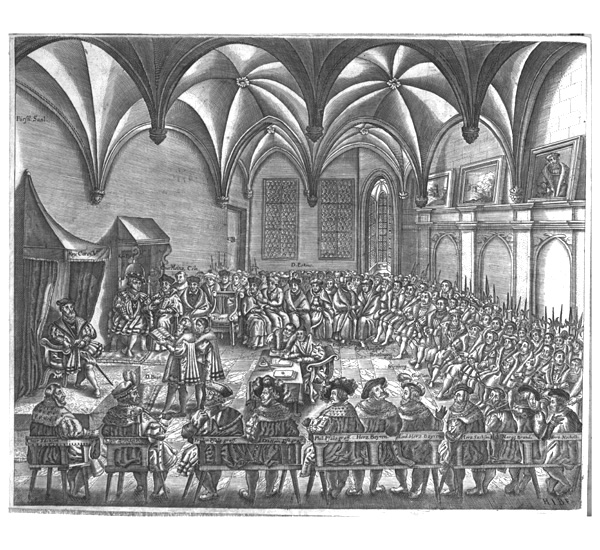Declaratio Ferdinandei on:
[Wikipedia]
[Google]
[Amazon]
 The ''Declaratio Ferdinandei'' ( en, Declaration of Ferdinand) was a clause in the Peace of Augsburg, signed in 1555 to end conflicts between
The ''Declaratio Ferdinandei'' ( en, Declaration of Ferdinand) was a clause in the Peace of Augsburg, signed in 1555 to end conflicts between
 The ''Declaratio Ferdinandei'' ( en, Declaration of Ferdinand) was a clause in the Peace of Augsburg, signed in 1555 to end conflicts between
The ''Declaratio Ferdinandei'' ( en, Declaration of Ferdinand) was a clause in the Peace of Augsburg, signed in 1555 to end conflicts between Catholics
The Catholic Church, also known as the Roman Catholic Church, is the largest Christian church, with 1.3 billion baptized Catholics worldwide . It is among the world's oldest and largest international institutions, and has played a ...
and Protestants
Protestantism is a branch of Christianity that follows the theological tenets of the Protestant Reformation, a movement that began seeking to reform the Catholic Church from within in the 16th century against what its followers perceived to b ...
within the Holy Roman Empire
The Holy Roman Empire was a Polity, political entity in Western Europe, Western, Central Europe, Central, and Southern Europe that developed during the Early Middle Ages and continued until its Dissolution of the Holy Roman Empire, dissolution i ...
. The Peace created the principle of ''Cuius regio, eius religio
() is a Latin phrase which literally means "whose realm, their religion" – meaning that the religion of the ruler was to dictate the religion of those ruled. This legal principle marked a major development in the collective (if not individual ...
'' (Latin for "''whose realm, his religion''"), which meant that the religion of the ruler decided the religion of the inhabitants. The ''Declaratio Ferdinandei'' exempted knights and some of the cities under the jurisdiction of an ecclesiastical prince if they had practiced Lutheranism
Lutheranism is one of the largest branches of Protestantism, identifying primarily with the theology of Martin Luther, the 16th-century German monk and Protestant Reformers, reformer whose efforts to reform the theology and practice of the Cathol ...
for some time (Lutheranism was the only branch of Protestantism recognized under the Peace). The provision was not publicized as part of the treaty, and was kept secret for almost two decades.
After Catholic victories early in the Thirty Years' War
The Thirty Years' War was one of the longest and most destructive conflicts in European history
The history of Europe is traditionally divided into four time periods: prehistoric Europe (prior to about 800 BC), classical antiquity (80 ...
, the ''Declaratio Ferdinandei'' was overturned in the Edict of Restitution
The Edict of Restitution was proclaimed by Ferdinand II, Holy Roman Emperor in Vienna, on 6 March 1629, eleven years into the Thirty Years' War. Following Catholic military successes, Ferdinand hoped to restore control of land to that specifie ...
of 1629, which was part of Ferdinand II's master plan to reconvert the Holy Roman Empire to Catholicism.Parker, pp. 87–88 The overturning of the ''Declaratio Ferdinandei'' and other religious persecution helped rekindle the Thirty Years' War, changing it from an internal conflict within the Holy Roman Empire into an international religious war.
References
See also
* Peace of Augsburg *Reservatum ecclesiasticum
The ' (Latin, "ecclesiastical reservation"; ) was a provision of the Peace of Augsburg of 1555. It exempted ecclesiastical lands from the principle of ' (Latin: whose land, his religion), which the Peace established for all hereditary dynas ...
Augsburg
Augsburg (; bar , Augschburg , links=https://en.wikipedia.org/wiki/Swabian_German , label=Swabian German, , ) is a city in Swabia, Bavaria, Germany, around west of Bavarian capital Munich. It is a university town and regional seat of the ' ...
Latin words and phrases
Augsburg
Augsburg (; bar , Augschburg , links=https://en.wikipedia.org/wiki/Swabian_German , label=Swabian German, , ) is a city in Swabia, Bavaria, Germany, around west of Bavarian capital Munich. It is a university town and regional seat of the ' ...
Christianity in the Holy Roman Empire
1555 establishments in the Holy Roman Empire
1629 disestablishments in the Holy Roman Empire
1555 in Christianity
1555 treaties